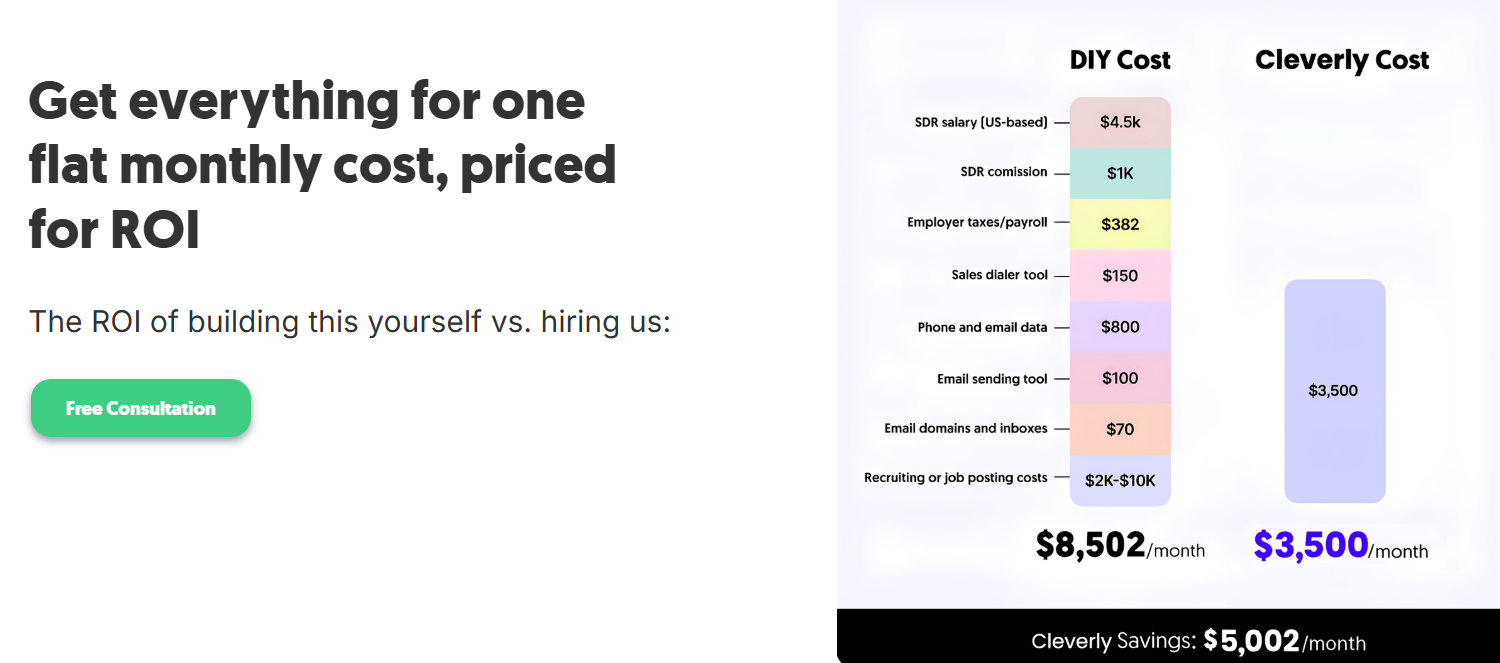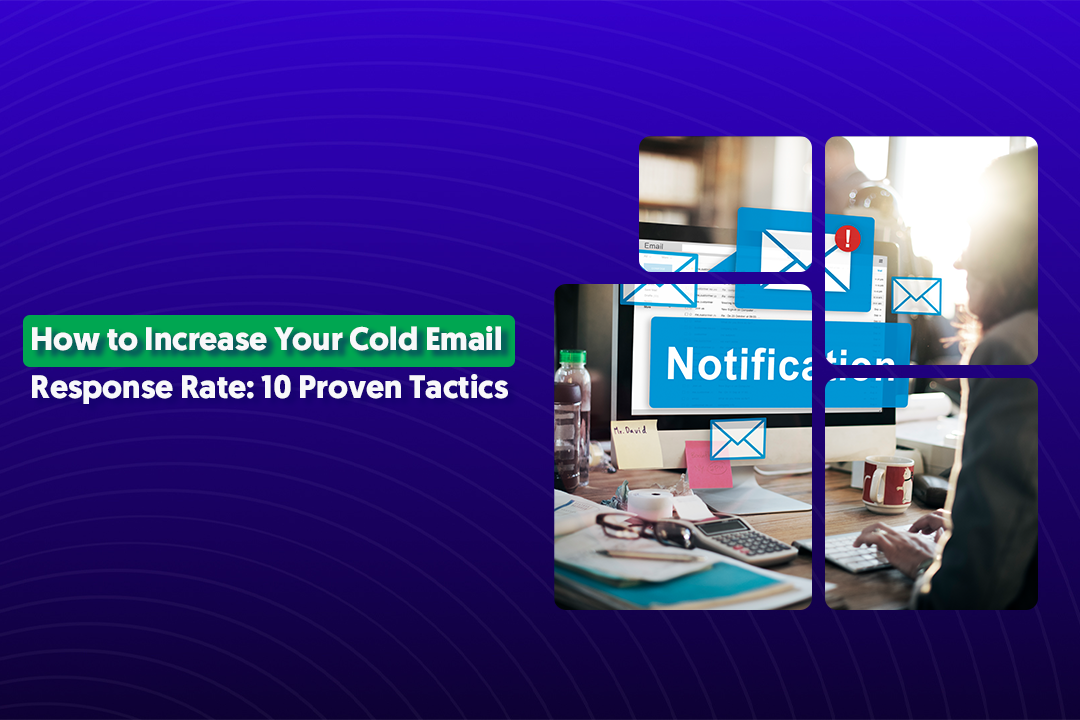Key Takeaways
- Timing is crucial—calling at the right hour can double your connection and appointment rates.
- Mid-morning (10–11 AM) and late afternoon (4–5 PM) are consistently the best time of day to cold call.
- Tuesday through Thursday are the most effective days for cold calling, while Mondays and Fridays are less productive.
- Industry-specific schedules matter—SaaS works best in mornings, real estate in evenings/weekends, healthcare early or after hours.
- Pairing good timing with strong scripts, multi-touch follow-ups, and voicemails boosts overall success.
- Leveraging data-driven cold calling services like Cleverly can significantly increase meetings, pipeline, and ROI.
You might have the perfect pitch, a solid list of prospects, and even the right contact information, but if you call at the wrong moment, chances are you’ll end up in voicemail or brushed off quickly.
That’s why figuring out the best time to cold call isn’t just a nice-to-have, it’s the difference between a wasted dial and a booked meeting.
In 2025, with changing work habits, remote and hybrid schedules, and busier decision-makers, the best time for cold calling has shifted compared to a few years ago.
Knowing when is the best time to cold call helps you not only increase your connect rates but also start conversations when prospects are actually ready to listen.
At Cleverly, we’ve seen this play out firsthand. After making over 1 million cold calls and setting 53,000+ appointments, we can confidently say that smart timing plays a huge role in building pipeline.
In this blog, we’ll break down the data and research behind the best time of day to cold call in 2025, so you can maximize every dial, or better yet, let us handle it for you with our done-for-you cold calling services.
Why Timing Matters in Cold Calling
When it comes to cold calling, timing isn’t just a detail, it’s often the deciding factor between getting through to a decision-maker or being ignored.
You could have the strongest script and the most persuasive opener, but if you call at the wrong moment, you’re far more likely to hit voicemail or get brushed off.
Here’s why timing matters so much in 2025:
- Prospects’ schedules are busier than ever – With remote and hybrid work becoming the norm, people’s calendars are packed with back-to-back Zoom meetings, internal check-ins, and email catch-up sessions. Calling in the middle of that chaos is a recipe for being ignored.
- Right timing = higher connection rates – Calling at peak times can double your chances of reaching someone live. A good call at the right time opens the door to meaningful conversations and booked meetings.
- Poor timing leads to missed opportunities – Call too early, too late, or right in the middle of a busy hour, and you’ll get nothing but voicemails, rushed conversations, or flat-out hang-ups. That wasted dial costs you both time and pipeline.
👀 Fact: Calls made between 4–5 PM are 71% more likely to connect than calls made in the morning
Best Time of Day to Cold Call in 2025
If you’ve ever wondered what the best time of day to cold call is, the short answer is: it depends on when your prospects are most open to listening.
The long answer? Certain windows consistently outperform others, and the data backs it up. Let’s break it down:
❌ Early Morning (8–9 AM)
- Many reps think calling right at the start of the day helps “catch” decision-makers before things get busy.
- In reality, early mornings are often packed with email catch-ups, planning, and internal team huddles.
- Calls at this time often end up rushed or go straight to voicemail.
✅ Mid-Morning (10–11 AM)
- Multiple studies show this is one of the best times of day to cold call.
- By 10 AM, prospects have settled into their day, cleared urgent emails, and are between meetings.
- They’re more open to conversations and less likely to feel interrupted.
- Connect rates spike between 10–11 AM compared to earlier hours.
❌ Afternoon (1–3 PM)
- Right after lunch, energy levels tend to dip. Prospects may be sluggish or focused on finishing big tasks.
- While you can sometimes connect here, it’s not usually a high-yield window.
✅ Late Afternoon (4–5 PM)
- This is the other sweet spot for cold calling in 2025.
- Prospects are wrapping up their day, clearing their inbox, or taking a breather between meetings.
- Calls made during this hour have the highest chance of connecting and leading to booked meetings.
❌ Evening (After 6 PM)
- For B2B, evenings are rarely effective—most decision-makers have logged off.
- For B2C, however, evenings can sometimes work better, since consumers are home and available.
Why These Times Work (Psychological Factors)
- Fewer distractions: Mid-morning and late afternoon are natural “pause points” in the day. Prospects aren’t rushing into the office or heading out the door.
- Energy levels: People are more receptive when they aren’t overwhelmed. After finishing priority tasks, they’re more willing to chat.
- Meeting breaks: Most corporate calendars have meetings stacked at the top of the hour. Reaching out between 10–11 AM or 4–5 PM often means catching someone in a gap.
B2B vs. B2C Differences
- B2B Cold Calling: Mid-morning (10–11 AM) and late afternoon (4–5 PM) are by far the best times of day to cold call professionals, especially decision-makers.
- B2C Cold Calling: Evenings or weekends sometimes perform better since consumers are available outside of work hours.

When Is the Best Time to Cold Call by Industry
The truth is, there isn’t a single universal answer to when is the best time to cold call.
While mid-mornings and late afternoons are strong across the board, the best timing often depends on the industry you’re targeting.
Every field has its own rhythms and schedules, and aligning your outreach with those patterns can make the difference between endless voicemails and a productive conversation.
SaaS & Tech

- In SaaS and tech companies, employees usually start their day early and spend mornings prioritizing tasks before meetings take over.
- Mornings (9–11 AM) tend to be the most effective window, especially for reaching product managers, engineers, and IT decision-makers.
- After lunch, most are buried in back-to-back meetings, making afternoons less effective.
Real Estate

- Real estate professionals are often on the move during business hours—showings, site visits, or client meetings.
- Evenings and weekends usually work best, when agents are wrapping up their day and have time to return calls.
- Saturdays, in particular, can be strong since many realtors work weekends.
Healthcare & Professionals

- Doctors, dentists, and other healthcare professionals usually see patients all day, leaving them unavailable during standard hours.
- Early mornings (before 9 AM) or after-hours (5–7 PM) are often the only times they’re reachable.
- Tailoring outreach here requires extra sensitivity, as their schedules are tightly packed.
Other B2B Sectors
- Finance & Legal: Mid-morning and early afternoons tend to work best, as mornings are often spent in client meetings.
- Manufacturing & Logistics: Early mornings are strong, as managers are on-site and accessible before production ramps up.
Why Tailoring Matters
Instead of relying on a “one-size-fits-all” strategy, you’ll get better results by matching your calling schedule to your prospect’s industry.
At Cleverly, we’ve seen that adjusting call times to industry habits can increase live conversations and appointment bookings significantly.
That’s why our cold calling services are customized—not only do we dial during the proven best times to cold call, but we also align outreach with your target industry’s workday.
How Data & Research Shape Cold Calling in 2025
In 2025, data and technology are no longer optional, they’re essential. Timing is no longer based on guesswork; it’s powered by real-time insights, predictive analytics, and years of industry research.
AI-Driven Dialers & Predictive Analytics

- Modern sales teams use AI-powered dialers that don’t just automate dialing—they actually predict the best time of day to cold call based on historical connection rates.
- Predictive analytics can analyze thousands of past calls to highlight when specific decision-makers or industries are most likely to pick up.
- This eliminates wasted dials and ensures SDRs are spending their time at the moments that matter most.
Leveraging CRM & Engagement Insights

- Your CRM is more than a contact database—it’s a goldmine of behavioral patterns.
- By looking at past activity (such as when prospects open emails, reply to LinkedIn messages, or pick up calls), reps can pinpoint when is the best time to cold call each contact.
- Over time, these insights allow you to build a custom calling schedule tailored to your audience, not just generic industry averages.
Cold Calling Research Trends for 2025

- Shorter response windows: Today’s decision-makers expect faster outreach. If you miss the right time, your window for engagement closes quickly.
- Mobile-first contact: With remote work and on-the-go decision-making, more cold calls are being answered on mobile devices. That means timing has to account for when prospects are most likely to be off desktop but reachable by phone.
- Data-backed scheduling: Many reports show that companies using AI and data-driven scheduling see up to 30% higher connect rates than those relying on traditional methods.
Tips to Maximize Cold Calling Success (Beyond Timing)
Knowing the best time for cold calling gives you an advantage—but timing alone won’t guarantee success. To really turn dials into appointments, you need to pair great timing with the right approach and strategy. Here are some practical ways to make every call count:
1. Pair Good Timing with Strong Cold Call Scripts

- Hitting the right time of day is only half the battle. The other half is what you say once your prospect answers.
- A clear, confident, and value-driven script makes prospects more likely to stay on the line.
- At Cleverly, we provide breakthrough cold call scripts designed to spark curiosity and move conversations toward meetings.
📌 All You Need to Know: Cold Calling Scripts That Actually Work (With Examples)
2. Keep Calls Short and Value-Driven
- Respect your prospect’s time. Instead of long monologues, focus on getting to the point quickly.
- Share one clear benefit or insight that relates to their role, then ask a simple question to open dialogue.
3. Use Voicemail Strategically

- Don’t treat unanswered calls as failures. A short, thoughtful voicemail can boost callback rates.
- Keep it under 20 seconds, highlight value, and mention you’ll follow up via email. This way, your name becomes familiar when you reach out again.
4. Follow Up via LinkedIn or Email
- If you don’t get through on the first attempt, reinforce your outreach on other channels.
- A quick LinkedIn message or follow-up email helps prospects connect the dots and builds familiarity.
5. Combine with a Multi-Touch Strategy
- Cold calling is most effective when combined with email, LinkedIn, and other touchpoints.
- Multi-channel outreach increases visibility and warms prospects before you even get them on the phone.
📌 Read More Here: Build a Winning Cross-Channel Lead Generation Strategy
Cleverly: Your Partner for Effective Cold Calling Services
If you’re serious about driving pipeline in 2025, you need more than just good timing—you need the right partner.
That’s where we come in. At Cleverly, our cold calling services are built to take the guesswork (and heavy lifting) off your plate while delivering results that actually move the needle.
Here’s what sets us apart:
- 100% done-for-you system – From SDR recruitment to training, scripts, data, and tech—we handle everything end to end.
- No-accent appointment setters – Professional callers trained to sound natural and build rapport quickly.
- Rigorous training to go live in 2 weeks – You get a fully operational cold calling engine in less than half the time of hiring in-house.
- Breakthrough call scripts – Written and tested to grab attention, spark conversations, and move prospects toward meetings.
- Data-driven timing – We align every campaign with the proven best time of day to cold call, maximizing connect rates and conversion potential.
- All-in-one setup – Data, tech, and power dialer included—no extra subscriptions needed.
- Guaranteed results – We stand behind our work: if your SDR doesn’t deliver, we replace them.
📊 Our track record speaks for itself:
- 1M+ cold calls made
- 53,000+ appointments booked
- $312M in pipeline generated for clients
- All at half the cost of in-housing your own SDR team

By combining research-backed timing with powerful scripts and a proven outreach system, we help B2B companies book more meetings, fill their pipeline, and grow faster.
Want to have a quick idea on how Cleverly’s cold calling services can work for your business? Let’s talk and start building your appointment engine!

Frequently Asked Questions
1. What is the best time to cold call in 2025?
The most effective windows are mid-morning (10–11 AM) and late afternoon (4–5 PM), based on research and real-world data.
2. What is the best day of the week for cold calling?
Tuesday, Wednesday, and Thursday are the top days, as Mondays are busy and Fridays are winding down.
3. Does the industry affect the best time to cold call?
Yes. Different industries have different schedules. For example:
- SaaS/Tech: mornings
- Real Estate: evenings and weekends
- Healthcare & Professionals: early mornings or after-hours
4. How many times should I call a lead before giving up?
It usually takes 5–7 touches across calls, emails, and LinkedIn messages to get a response, depending on industry and prospect behavior.
5. Should I use a cold calling service for better results?
Absolutely. Professional cold calling services like Cleverly optimize timing, scripts, and follow-ups, increasing live conversations, booked meetings, and pipeline without the hassle of in-house setup.





